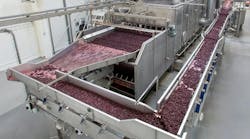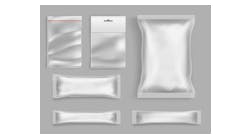Much of the conversation around sustainability centers on packaging and what can be done to reduce, reuse and recycle as much of it as possible. However, the growing consumer awareness of food waste continues to transform the discussion.
A 2014 Harris Poll conducted on behalf of Sealed Air found that the amount of food waste in the U.S. has doubled per person over the past 40 years, representing $160 billion dollars of wasted product for the entire country and costing households an average of $2,000 per year. In fact, the U.S. Department of Agriculture estimates that 31 percent of all food in the U.S. now goes to waste. The challenge stretches beyond the shores of the U.S. A 2015 study by the European Commission Joint Research Centre estimates that 16 percent of all food reaching consumers goes to waste in the UK, the Netherlands, Denmark, Finland, Germany and Romania.
As much as food waste afflicts many industries around the world, the impact of wasted meat product can be even larger on the environment, consumer budget and brand owner bottom lines. To reign in the issue, meat product manufacturers are taking a second look at packaging – not as material to be minimized, but as the solution to extend product shelf life and keep more of their goods in kitchens and out of landfills.
Tomorrow’s flashpoint
One of the food categories especially at risk for becoming a food waste flashpoint in the coming years is meat.
Although less meat is wasted than other food products, according to a 2015 study commissioned by the University of Missouri at Columbia, the environmental impact of meat production is greater compared to that of vegetables. By the time a consumer gets a piece of steak on his or her plate, the amount of CO2 released to feed the cows, maintain the cows and other supply chain needs accumulates and counts toward the environmental footprint of the product. In fact, The Guardian reported in 2014 that the impact of beef per calorie requires 160 times more land and produces 11 times more greenhouse gases compared to non-meat staples like potatoes, wheat and rice. As a result of these observations, the UMC study’s co-author recommended that consumers pay special attention to avoiding waste when purchasing and preparing meat. So, as the sustainability conversation shifts focus to food waste, the meat category can be singled out for special attention.
New food packaging technology to the rescue
The packaging industry can play a critical role in meeting this problem head on, and will likely play an even larger role in solving it in the coming years thanks to new solutions either hitting the market or coming down the Research & Development pipeline.
Packaging technology suppliers had already focused on the food waste issue before it emerged as a public concern for a few reasons. One reason is that brand owners want their retail partners to succeed, and nothing hurts sales like a meat case filled with product that doesn’t appear to be the freshest possible. Another reason is that meat product manufacturers and their packaging suppliers have already been addressing the challenge of extending shelf life for organic lines. As demand for organic, preservative-free meat, poultry and seafood options grows, processors are prioritizing the implementation of solutions to keep their foods fresh without the use of traditional chemical preservatives.
Additionally, the typical household in the United States and other western countries is shrinking. With fewer mouths to feed amid smaller family units, significant strides have been made to implement packaging solutions that reapportion meat servings. This offers greater convenience to consumers and, combined with other measures to preserve and indicate freshness, amounts to a superior brand experience.
The next generation of smart labels
One way that packaging can play a role in keeping perishable products like meat fresh is through smart labels. In recent years, these labels, which can do everything from tracking the product through the supply chain, to logging temperatures along the route, have become even more advanced and less costly.
For instance, second-generation smart labels are hitting the market, allowing for the use of special inks that become visible to the eye if meat may have reached an unsafe temperature while traversing the supply chain. What’s more, the cost of these smart labels has come down – to as little as 1 cent in some cases – to make their application possible for individual packages of meat, not just entire cases. This provides further cost efficiencies and less waste, as retailers can simply dispose of individual units rather than entire caseloads of product if freshness becomes compromised.
QR (quick response) codes, which enable consumers to interact with packaging using their smartphones, are also being used by manufacturers to cut down on the amount of food that goes to waste, while also providing a competitive advantage when it comes to food safety. In China, for example, Tyson recently began using QR codes to give consumers confidence that its chicken products are fresh. Consumers can scan the QR codes on Tyson chicken to trace its point of origin and also find out when it arrived at the store.
Packaging on the cutting edge
In addition to communicating about product freshness to consumers, packaging is better equipped than ever to preserve product freshness. In January, the European Union announced a project called NanoPack to introduce nanotechnology-based antimicrobial packaging to enhance food safety and reduce waste.
NanoPack aims to develop and demonstrate state-of-the-art antimicrobial packaging solutions for perishable foods like meat based on natural nanomaterials that will prevent foodborne illness outbreaks and reduce food waste caused by early spoilage.
The active polymer films developed by NanoPack exhibit broad-spectrum antimicrobial properties. Applying the power of nanotechnology, the project will employ polymer composites based on natural halloysite nanotubes (HNTs) as reliable and safe carriers, capable of tailored release of bioactive payloads. Due to their size, HNTs are unable to migrate from the food packaging into food. Maximizing safety, HNTs in the NanoPack food packaging slowly release minute amounts of potent, volatile, natural and EU-approved essential oils into the packaging headspace. The oils exhibit both antimicrobial and antifungal properties and can be tailored to inhibit the growth of most foodborne microbes.
Additional packaging options that not too long ago would have been considered science fiction are also currently being researched. Self-cooling packaging using chemicals or gasses, or through the use of an ultra-thin power-source in the packaging, are just a few of the possibilities currently being explored. Even predictions of self-healing polymers that could automatically close any puncture in a package to prevent spoilage could be a reality in a matter of years.
References
- https://ec.europa.eu/jrc/en/news/average-eu-consumer-wastes-16-food-most-which-could-be-avoided
- https://www.theguardian.com/environment/2014/jul/21/giving-up-beef-reduce-carbon-footprint-more-than-cars
- http://munews.missouri.edu/news-releases/2015/0812-meat-food-waste-has-greater-negative-environmental-impact-than-vegetable-waste/
- http://finance.yahoo.com/news/tyson-foods-adds-qr-code-203508305.html
Jorge Izquierdo is vice president, marketing development, at PMMI, The Association for Packaging and Processing Technologies. PMMI, The Association for Packaging and Processing Technologies, represents more than 800 North American manufacturers and suppliers of equipment, components and materials as well as providers of related equipment and services to the packaging and processing industry.
PMMI, The Association for Packaging and Processing Technologies



